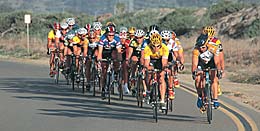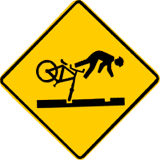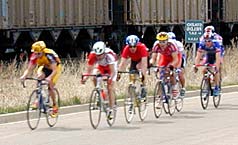Group-Ride Etiquette
Riding is more fun when you ride with others!
 There's no better source of motivation, knowledge and camaraderie than your fellow riders.
There's no better source of motivation, knowledge and camaraderie than your fellow riders.
However, riding in a group can be tricky.
Pick The Right Group Ride
Group-ride levels and objectives vary. Determining the group's goal and pace will ensure that you join a ride that's right for you.
- Is the ride social or sadistic?
- Is it considered a training ride or a training race?
- How far will the group go?
- What route will it follow?
- What are the rendezvous points?
- Are there any rest stops?
- Will quicker riders wait for those who've been dropped?
Answer these questions before the ride. so you don’t jump into a blistering hammerfest when all you wanted was a social "coffee" ride and vice versa.
Here are some local cycling groups.
Communicate
Communication is the key to safe group rides. When riding in a group, it's important to warn others about hazards.
Warnings you're likely to hear include:
- Car back: there's a car approaching the group from the rear
- Car up: car approaching from the front
- Car right (or left): a car's approaching on a cross street
- Stopping: the group is stopping for a stop sign or light
- Gravel, Sand, Glass or Hole: there's a road hazard ahead

Don't let this happen to you!
Ride Smart To Stay Safe
Group-ride dynamics are interesting and ever-changing. In order to ride safely it's important to ride smoothly and avoid hard braking as much as possible. In fact, even light braking or swerving by someone in front can have a ripple effect and cause problems at the rear of the pack. Inexperienced riders who panic and touch a wheel may crash. Never fear! You can avoid problems by practicing these simple rules:
-
Stay alert at all times. Never assume that it's safe.
-
Hold your line. This means swerving as little as possible. If you need to move left or right, do so gradually after checking the area for other riders and pointing out your move to make your fellow riders aware of your intentions.
-
Don't overlap wheels. Overlapping is putting your front wheel next to someone's rear wheel.
-
Don't look back! Looking back causes even skilled riders to swerve, which can cause a crash. If you must look back, ask the person next to you if you can put your hand on their shoulder.
-
Relax! Use a relaxed grip on the handlebars
-
Focus on the rider(s) ahead. Don’t make the common mistake of focusing on the back wheel in front of you. Look up at the shoulders of the riders ahead and occasionally look at the road ahead
-
Don’t brake unless absolutely necessary. If you must brake, do so lightly to scrub off a little speed. You can also slow down by sitting upright and catching more wind in your chest.
-
Warn others of hazards. Keep on the lookout for things that could cause problems and shout out a warning or point out the hazard.
-
Pass carefully. Sometimes you'll see the riders ahead starting to accelerate and you'll want to jump up to them. Be careful! Make sure you're not going to get cut off or cut someone else off.
-
If you get tired, move to the rear. Fatigue causes dangerous riding
Be Prepared

You travel further and faster in the group.
Be prepared for the challenges of the ride. Learn the route ahead of time to ensure you don't get lost. Also, if you know the route, it's easier to shortcut the ride if you get into trouble.
